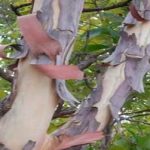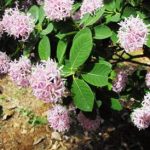TREE LIFE
June 2013
MASHONALAND CALENDAR
Saturday June 1st: Botanic Gardens walk with Tom Muller. Meet at 10.45am in the car park of the Botanic Gardens. This will be Tom’s last outing until his return from England in October.
Sunday June 16th: Visit to the Alexanders’ property in Ruwa. We will meet at 09.30. Bring your lunch and chairs as usual.
Saturday June 22nd: Visit to Haka Game Park. Time 14.30. There is an entrance fee.
TREE OF THE MONTH
Adenium multiflorum
Family: Apocynaceae. Botanical names: Adenium multiflorum (Adenium obesum var multiflorum. Common names: Sabi Star, Impala Lily, Desert Rose, T: Mbwayumba, Sh: Chisvosve.
J.J. Roemer and J.A. Schultes established the genus Adenium in 1819; up to 12 species have been described. However in the most recent revision by Plazier, only five species are recognised. The generic name is derived from the vernacular name for Adenium obesum, namely Oddaeyn, or from Aden, where A. obesum was first collected. J.F. Klotzsch described A. multiflorum in 1861 from material collected in Mozambique. The Latin specific epithet refers to the multitude of flowers produced by this plant. In earlier revisions, L.E.Codd considered A. multiflorum as a variety and G.D. Rowley as a subspecies of a very closely related but more northerly distributed species, A. obesum. In the latest revision, it was raised to species level again. (Plantzafrica.com).
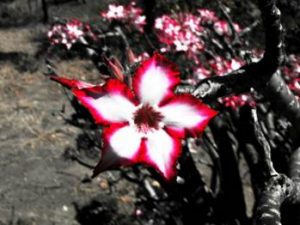
Adenium multiflorum
The family name, Apocynaceae, is Greek for “plant lethal to dogs” as some Apocynaceae contain a toxic milky sap. The best known Apocynaceae in Zimbabwe is Plumeria rubra, the Frangipani, an exotic from Mexico. Indigenous and fairly common at home we should mention the Carissa spp. (edulis and bispinosa), the Acokanthera (rotundata and oppositifolia) and Diplorhynchus condylocarpon.
Adenium multiflorum is, in Zimbabwe, a specially protected plant. One needs a special licence to cultivate, propagate or sell it. The status of hybrids in that respect is not clearly defined. For enlightenment just type “Thailand adenium” into your net browser and you’ll be flooded with hybrids of the various species; but it seems that multiflorum, possibly because of its slower growth rate, has not been a favourite.
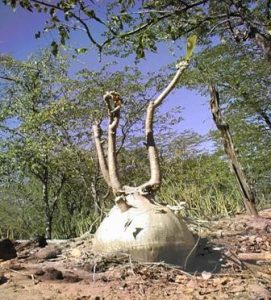
Adenium multiflorum growing where not disturbed by wild game or cattle
And now to come back to our very own Sabi star. Some people may be surprised to find that Adenium multiflorum is classified as a tree. Unfortunately they are grazed by wild and domestic animals and they rarely have a chance to grow to their full stature. The pictures were taken on an island near Mlibizi (S17°56,395’ E027°04,112’) on Lake Kariba at Easter 2003. Since the completion of Operation Noah over 50 years ago, most islands have been free of wild life and the botanical biodiversity is now excellent.
Adenium multiflorum is a deciduous succulent shrub or small tree, growing from 0.5 to 3m tall. Stems arise from a large underground rootstock (see picture to the right). The bark varies from shiny grey to brown, with poisonous watery latex. For most of the year the plants do not have flowers or leaves. The leaves are about 100 mm long, shiny green above and pale green below. They are carried in clusters at the growing tips of the branches and they are shed before flowering. The flowers are borne in terminal inflorescences, each flower 50 – 70mm in diameter. They vary greatly in colour, usually with pointed white lobes, crinkly red margins and red stripes in the throat. The flowers are sweetly scented. Flowering occurs from May to September.
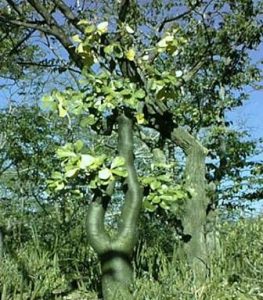
Adenium multiflorum growing where not disturbed by wild game or cattle
The fruit is paired, 2 cylindrical follicles up to 240 mm long. The seeds are brown with a tuft of silky hairs. The pods are dehiscent and the tufts of hair at the ends of the seed help the seeds to roll on the ground like miniature axles.
Medicinal uses. “The Traditional Medical Practitioner in Zimbabwe” mentions an infusion of the root to treat blood in urine in cattle and diarrhoea and sore eyes in poultry. The use of Adenium arrow poison is also reported from Senegal, Nigeria and Cameroon. A decoction of the bark and leaves is widely used as fish poison. This use is reported from Nigeria, Cameroon and East Africa. In Mauritania and Senegal preparations from Adenium are used as ordeal poison and for criminal purposes.
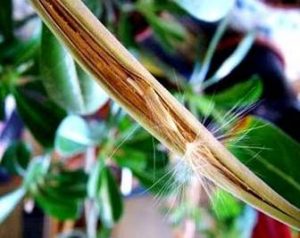
Adenium multiflorum seed pod
In the Sahel a decoction from the roots, alone or in combination with other plants, is used to treat venereal diseases; a root or bark extract is used as a bath or lotion to treat skin diseases and to kill lice, while latex is applied to decaying teeth and septic wounds. In Somalia a root decoction as nose drops is prescribed for rhinitis. In northern Kenya latex is rubbed on the head against lice and powdered stems are applied to kill skin parasites of camels and cattle. The bark is chewed as an abortifacient (findmeacure.com/2009/11/18/desert-rose).
Interestingly enough the toxic nature of the plant does not deter baboons from digging the roots out and eating them.
Sources:
Find Me A Cure: Desert Rose. findmeacure.com/ 2009/11/18/desert-rose
Gelfand et.al. 1985. The Traditional Medical Practitioner in ZImbabwe. Mambo Press, Harare.
SANBI. www.plantzafrica.com
Wikipedia. https://en.wikipedia.org.
– JP Felu
OUTING TO MAVHURADONHA WILDERNESS ECO-LODGE THURSDAY 21 MARCH – SUNDAY 24 MARCH, 2013
Episode 1 Thursday 21st March
After months of meticulous preparation by the trip organiser Bill Clarke, Thursday March 21st finally dawned and 32 Tree Society members set off for Mavhuradonha Wilderness Eco-Lodge for 4 days of studying trees and socialising.
This location has a number of positive features, namely the easy access (about 2.5 – 3 hours from Harare on a good tarred road), the fact that it can accommodate the numbers involved and that it can also provide catering.
We assembled before lunch at the Central Tree, a large Piliostigma thonningii, Monkey bread, which provided nice shade during the day. There we were greeted by Bill with a welcoming tot of sherry. Lunch was then served, the first of many pleasant meals we were to eat on the trip.
After lunch some of us set off on early botanising to “get our eyes in” for the next few days. The area around the Central Tree lies between two rivers; both of these have a well-defined riverine fringe vegetation and in between is an area which is partly riverine and partly consists of disturbed areas and planted trees. This area we were to look at on Friday, the next day. The altitude around the lodges is just under 1100 m, quite a bit lower than Harare but also quite a bit higher than Muzarabani down on the Zambezi plain, which lies at around 460 m above sea level.
On our afternoon recce we walked back along the main road which leads into the camp. A couple of interesting herbaceous plants seen were Desmodium velutinum, together with its weedier cousin, the Silverleaf, Desmodium uncinatum. D. velutinum was a first for me although Meg has recorded it before in Mozambique. It is a legume, a native plant and is easily recognised by the leaves which are all broad and simple.
In the woodland were numerous Pericopsis angolensis, Muwanga, with their distinctive pale bark. Another tree with distinctive bark seen was Stereospermum kunthianum, the Pink Jacaranda. Common around the area (and also frequent by the road on the journey from Harare) was Acacia amythethophylla, the large-leaved acacia. This late-flowering species has exceptionally big 2-pinnate leaves and also a large orange-flowered panicle. Also seen was the Tassel-berry, Antidesma venosum.
In the woodland was Bridelia micrantha, Mitzeerie,, often recognised by its autumn colours and the lateral veins of the leaves which go straight to the edge. Climbing on shrubs was Thunbergia crispa. This is one of the most beautiful and garden-worthy wild plants with deep blue flowers and a paler, slightly curved corolla tube. This is rather a local species but we do encounter it from time to time.
Very common in the woodland was Bauhinia petersiana subsp. petersiana, the Large white Bauhinia. This white-flowered species was not in its usual flowering period at this time of the year, but we did come across a few late flowers. We were told that the red-flowered species, Bauhinia galpinii, the Pride of the Cape, also occurs in the area.
People began to gather at the Central Tree as darkness came on and dinner was served at 6.45 pm. After dinner there were brief opening addresses by Bill, Meg Coates-Palgrave and myself. This was the first of three very convivial evening dinners.
– Mark Hyde
Friday morning, 22 March Quarter degree square 16:31:A3
Our first morning at Mavhuradonha was spent in the surroundings of the beautiful and well-kept campsite, where there turned out to be plenty to interest the plant-lover. Over breakfast at 8.15, we heard first of all from our camp geologist Peter van der Spuy, son of the late well-known South African botanist and master-gardener Una van der Spuy.
We were, Peter explained, at the northernmost end of Zimbabwe’s Great Dyke, a feature known as the Snake’s Head. The Dyke itself is 2.4 billion years old, half the age of the Earth, and contains some of the world’s oldest granitic rocks, as well as large deposits of chrome, platinum and nickel. The latter mineral, which is enriched a thousand times to 1% of the soil content in this particular area, discourages the growth of some trees on the Dyke. An exception to this is the yellow-tufted Alyssum genus, native to Europe and North Africa, which is a “super-absorber” of nickel, being able to thrive on the elevated concentrations of the metal. When Alyssum plants are cultivated in nickel-rich soil and then burned to ash, a percentage of the mineral can be extracted from the leaves. Peter hopes this will become a good economic activity in the future, though it’s not viable at present – the plant needs to be carefully controlled as it can spread as a noxious weed.
After breakfast we split into two groups for the walks, one party being led by Meg, the other by Mark, and we changed over after tea. As it turned out, we were able to observe about 20 plants per session – 41 in all. Many of these trees were numbered according to a list put together by Mark and Meg and sent to us before the trip, for ease of reference. Some were well-known, but others were less so, and so the two sessions were a voyage of discovery for all. Setting out from our Piliostigma thonningii (monkey bread) central tree, Meg led our group in the direction of a Brachystegia utilis, which seemed to be at its upper altitude limit (1050m) at the camp, having been seen on a previous outing at James Varden’s property a little lower down the Zambezi escarpment.
Next to this was an attractive Bauhinia petersiana, whose seeds make a hot drink, and a little further on the spiny Acacia sieberiana. There appeared to be some galls, or parasites, on this tree, and Meg explained that these parasites are usually host specific, which means that a species of tree will host one in particular. Beneath a “snot apple” tree, Azanza garckeana, we got a short lesson on how to recognise some of the “labels” on trees that help you identify them. In this case, it was the presence of prominent extra-floral nectaries, or glands, on the leaves. The purpose of these nectaries, which are long narrow fissures in the leaf-midribs, is to attract ants, which then keep the aphids away.
Our next stop was under a beautiful Stereospermum kunthianum, or Pink Jacaranda, from the family Bignoniaceae. This tree has unmistakeable, nearly symmetrical patterns in subtle colours on its smooth bark. Next it was the turn of the fig tree to get our attention, a Ficus thonningii, or common wild fig, with striking white aerial roots. This specimen grows on a stone wall near the camp generator. A “label” for easy identification of the Ficus genus is the milky sap, prominent stipules and scars, and the long petioles, or leaf-stalks (up to 45mm in some cases) with the leaves looking like they’ve been stuck on with glue. As we admired the glorious white roots of the Ficus thonningii, Meg remarked on the importance of root shoots, as from these a lot of bush re-growth occurs, in habitat that has been disturbed. A new addition to the list of campsite trees was stumbled upon next, one not previously observed: Carissa edulis, the simple-spined Num-num.
At the top end of the campsite grows a magnificent Ficus sycomorus, the real sycomore tree mentioned in the Bible. This tree fruits prolifically along its trunk and main branches, unlike other kinds of Ficus which generally only bear fruit on the terminal branchlets. The fruits are pollinated by a tiny fig wasp, and Meg shared with us the interesting story of the Biblical prophet Amos who was employed as a “nipper of figs” because the sycamores, being imported into the Middle-East regions, have no wasps to pollinate them and so the figs need someone to make a tiny hole in them if they are to ripen.
The first walk ended with a look at some Acacia amythethophylla, or large-leaved thorn trees. These trees were in flower at this time, an interesting though overlooked fact being that all the trees in an area have to “book their slot” to flower, as it were, and avoid all flowering at once, in order to have a monopoly of pollinating insects.
Session two after tea took our group in the opposite direction, this time with Mark. Our first stop was beneath a tall and magnificent Acacia polyacantha (its “label” being the large gland at the base of the leaf stalk) which had a parasitic climber on it. This turned out to be Plicosepalus kalachariensis, whose leaves are cold to the touch. The reason for this, Mark explained, is to enable rapid transpiration, which assists the climber to draw water and nutrients out of the host tree.
Treading carefully over some Setaria homonyma (bristle grass) we next made our way to a tree which turned out to be the mwanga, Pericopsis angolensis, with its burden of dead branches which is a label for these trees. Several Muwangas can be seen around the campsite, towering over the surrounding canopy, always labelled with these skeletal branches. Next there was a Tassel-berry, Antidesma venosum, whose unisexual flowers are unusual in plants. A short distance away, towards the river, grows a beautiful Tamarind tree, Tamarindus indica, a tree which is very widespread in Africa and Asia, and is unmistakeable with its deeply fissured, corky bark. Tamarindus indica resembles the Mountain Acacia, found in the Eastern Highlands, and there has been some disagreement about how to classify the latter. It is now called Brachystegia tamarindoides.
Next it was time to go down to the river’s edge. As you would expect, this was a more crowded, densely packed ecosystem with lots of plants close together. The first to catch the eye was a Ficus burkei, growing on an obliging Acacia and trying not to strangle it (though it eventually will): The milky sap and spiral leaves are labels for this fig. All along the edges of the river was the abundant river sedge, Cyperus involucratus. This sedge, which resembles the papyrus reed, is a rhizome and spreads along the river bank using its roots. A tall tree, growing at an angle over the river bank, towered over the reeds and was identified as Bridelia micrantha, the mitzeeri. There was also a Ficus sur and the “eared” vernonia, Vernonia myriantha, which has very prominent stipules, hence its common name.
Around the campsite, several Baobabs, Adansonia digitate, are found. These, judging by their compound leaves and slight stature, are young trees, and they are not especially eye-catching in the wooded, riverine environment of the camp, where one does not expect to see them. Like other species at the Lodge, they have been planted there, but seem to be thriving and holding their own. One such young baobab, its leaves giving a pleasant scent when crushed (these leaves can be cooked and eaten) provided a diversion in our exploration of the river bank. Noteworthy species during this part of the walk were Rhus longipes, whose ripe fruits taste of raisins and whose trifoliate leaves have an identical hairy texture above and below, unusually (an observant member of our group remarked on this fact), and Ziziphus mauritiana, masau or jujube, another widespread tropical tree like the tamarind.
Visible by the river was also Desmodium uncinatum, the silver-leaf, a South American climbing species introduced as fodder for cattle, which now invades local biomes. Mark also pointed out to us the climbing Clematis brachiata, and a Milkwood tree, Mimusops zeyheri, which produces milky latex, or sap, though not very plentifully. This particular specimen was no different and showed unwillingness to yield its latex despite our coaxings. Proceeding past another Pink Jacaranda we noted a shade-loving Euclea racemosa, and then Mark introduced us to another tree, the exquisite Flacourtia indica or Governor’s Plum, which has an edible fruit and delicate pink leaves, reminiscent of the colours of ripe tangerine or grapefruit.
Turning back from the river towards the campsite, we headed towards a shapely Cordyla africana, or Wild Mango. The label for this tree is the leaf: examine this against the light and tiny translucent dots and streaks are visible. The Cordyla, whose distribution is a little restricted in Zimbabwe, stands near a patch of open ground, where certain tiny flowers, Striga asiatica or Witchweed, grow. This is a widespread parasitic plant which causes huge crop losses in Africa and elsewhere and is very difficult to eradicate. But it’s a pretty flower when you see it growing innocuously in a campsite. As we headed back towards the Central Tree, our familiar Piliostigma, Mark spotted some interesting bulbous appendages suspended high in the canopy overlooking the small chalets. These turned out to be “air potatoes”, in the genus Dioscorea. They grow on long vines and are related to yams. Edible when cultivated, they can be poisonous when growing wild. Nearby, we came upon a Sjambok Pod, Cassia abbreviata, and a specimen of Dombeya rotundifolia, the common Wild Pear. Visible roundabout, in the undergrowth, was the well-known Black-eyed Susan vine, Thunbergia alata, and our final tree on Mark’s walk was a familiar Combretum collinum, with its sophisticated 4-winged seed pods.
Since lunch appeared not to be quite ready yet as we headed back to the central Piliostigma, we took a small detour up towards the main road, where we were introduced to Pseudarthria hookerii, the Velcro bush, whose trifoliate leaves stick to clothing in a very satisfactory fashion, and also to the shy “don’t touch me” tree, Biophytum umbraculum (formerly known as petersianum), whose leaves fold up when you touch them. We also viewed two more magnificent Muwangas, which towered above the surrounding canopy, labelled by their trademark burdens of dead branches. We then returned to camp for a very enjoyable lunch.
– Richard Hartnack


